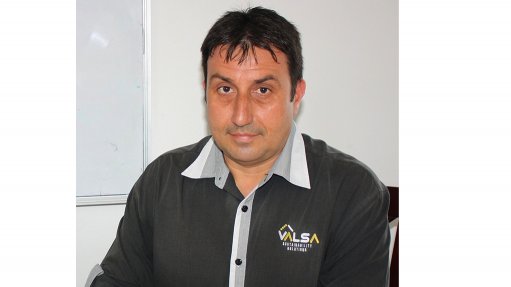
SVILEN VOYCHEV Significant planning is required to find the right PV solution for the each mine
As the trend towards decarbonisation gathers momentum, photovoltaic (PV) solar system manufacturer and distributor Valsa Trading, suggests that PV solar as a renewable, low-cost energy source continues to provide the mining industry with the opportunity to reap the benefits of renewable energy in the shortest time possible.
Valsa MD Svilen Voychev says PV solar solutions can ensure that mine operations are not disrupted for prolonged periods, as they can be deployed quickly. However, he stresses that this time-saving benefit depends on whether skilled and knowledgeable installers are used to install the PV solution.
Considering the cost of the electricity generated and the cost of the connectivity period, solar is one of the most competitive, effective options for mine operations, he adds.
Other renewable-energy solutions, such as wind turbines, can also assist mines. However, PV solar, by comparison, is quicker, easier to install, and offers more manageable and measurable options.
A significant part of the installation process is understanding an operation’s specific needs; therefore, expertise brought to the PV solar project is key to mining operations’ receiving the best possible solution.
PV solar can form part of either a centralised or decentralised system and can be customised to meet a mine’s exact power requirements.
It can also be implemented in phases, with the completed segments generating power while the other segments of the system are installed. This enables mines to benefit from their investment when the first segment is ready to generate power.
Mines can also house the PV system on unused areas or spaces on their existing mining right area. Valsa also provides equipment and solutions, such as a floating PV solar system, which can enable mines to use any available space, including on or near dams or ponds.
Further, substituting grid power with PV solar power enables mines to become sustainable and can offset some of their power consumption during peak demand periods.
Miners can use PV solar as a means of reducing their reliance on the power grid rather than a complete off-grid dependency. Voychev suggests that mines can integrate solar power into an energy mix that uses multiple sources of energy to create a harmonious, continuous supply of power.
“PV solar power has certain capacity and capabilities, but it can also be linked with other sources such as diesel-powered generators, [which] can supply power when the PV solar system is unable to do so,” says Voychev.
Mining operations can also consider using battery storage solutions.
“Although it has been considered a more expensive option, the cost has been significantly improving over the past two to three years to make it a more feasible option that can be accessed to enable mines to store energy for periods when PV solar cannot generate power,” he elaborates.
Expertise Ensures Efficiency
Voychev reiterates that it is important to understand the existing infrastructure of the mine site and the operational needs to create the correct or sufficient power mix.
In Valsa’s experience, it usually requires significant planning until the right solution for the mine is finalised.
Therefore, it is important to ensure that the planning of integrating PV solar is a solutions-based approach, rather than simply installing the PV system upon request. The requirements of the mine and return-on-investment period are factors that must be evaluated to ensure that mines receive the best value possible.
Voychev explains that the initial project development stage needs to involve experts that can account for various factors and aspects. These include progressing a feasibility study, determining investment and finance-related aspects, and forecasting the timelines for PV solar’s integration into the mine’s energy supply.
Disruptions caused by the Covid-19 pandemic have resulted in supply chain delays, which, in turn, have resulted in project planning becoming more critical, both to ensure the availability of specific products and components, and that delays affecting project completion are factored into the project timeline.
Voychev comments that experts can foresee what obstacles might occur throughout the project and can take precautions, such as ensuring that the required equipment is available, thereby avoiding further delays or unexpected costs.
The local conditions of the mine site have to be considered, as they are key to establishing the suitability of certain equipment and solutions.
“This is so important to know from the beginning because it affects the procurement cost projects and project timelines,” he adds.
Valsa focuses on bridging the gap between providing quality solutions and equipment, as well as the expertise to ensure that projects are customised to client specifications.
The company values providing expertise to make the implementation process shorter while ensuring that the solution is well designed and completed within budget,when possible.